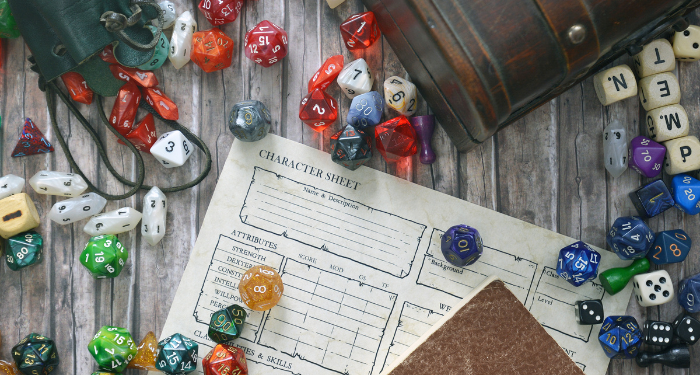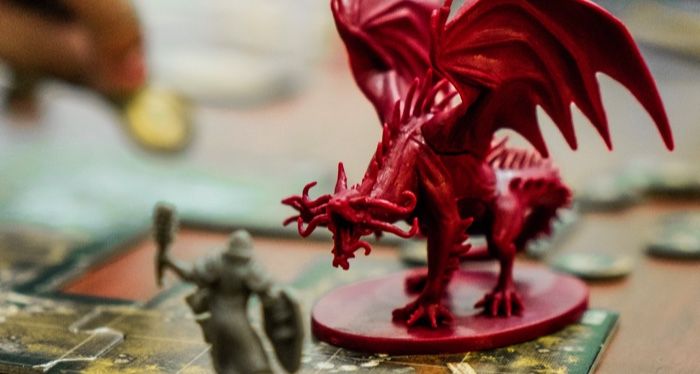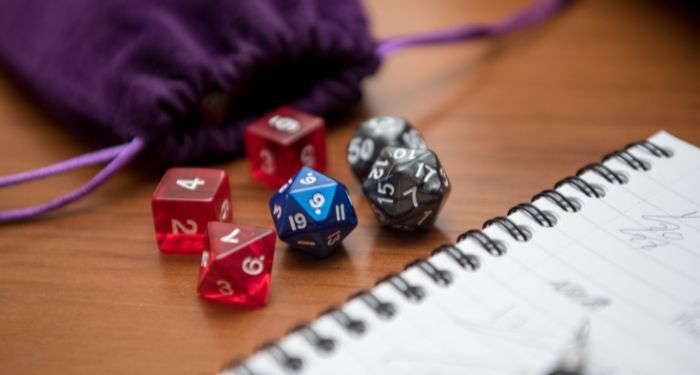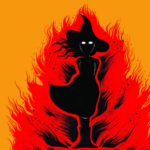
Pathfinder vs. Dungeons and Dragons: Which Should You Play?
Wondering whether to play Pathfinder vs. Dungeons and Dragons? I’m here to help.
I have been a TTRPG (tabletop roleplaying games) player for nearly a decade. I’ve played D&D, Pathfinder, Starfinder, Kids on Bikes, Monster of the Week, Cyberpunk, and so many more. There are some truly amazing games out there in the TTRPG world, though some are more known than others. You’ve got the big names like some I listed above, but there are also incredible smaller indie games out there you absolutely should be looking into. Most of the time, if people know about TTRPGs, they are going to know of Pathfinder or D&D. Due to online popularity, D&D is likely the most well-known game currently, but that doesn’t necessarily mean it’s the best.
We are going to look at Pathfinder 2e and D&D 5e to see what the core differences are. Maybe reading this will help you pick which game you want to start with or convince you to give the other game a try if you already play one. As someone who both GM’s (game master) and plays, I’m going to look at gameplay on both sides of the table: what the differences are in running the game and what they are in playing a game.
This is a topic that has been covered a lot and is the subject of debate in many nerd circles. My goal here is not to argue the superiority of one over the other or try to settle this age-old debate. The goal here is simply to help you decide what to play at your next game night if you’re considering Pathfinder vs. Dungeons and Dragons.

Character Creation: Pathfinder vs. Dungeons and Dragons
Both of these games begin with creating the character you are going to be playing throughout the campaign. In both games, you choose your ancestry, your class, and your history. These choices impact the bonuses you get in the game and the flavor of how you play your character. Are you going to blast off spells or hit someone with a hammer? Are you going to both? That all depends on the character you create.
The main difference I’m going to be talking about today is the amount of choices available to you at level one in each system because that varies a lot.
Player Perspective
If you are just using the standard books from D&D, your character options are a little more restricted. You chose your race, your background, and your class. Some classes allow you to choose a subclass right away, while others don’t. That’s pretty much it. There are some cases where you can choose a feat, which is like a special little bonus attribute. And depending on your class, you can choose spells or your fighting style — all of which are limited. As you level up, you get new options, but you are usually only making one or two choices per level, and often your decisions cannot be reversed.
Starfinder has a lot more customization options, which can be great because there is so much variety that every game feels totally fresh. It can also make it a bit overwhelming if you’re new to the character-creation process. Each class comes with unique choices that can add complexity to the character. Pathfinder also has a lot more options which each level up, with the ability to change things as you go and get to know your character. It can seem intimidating, but taking it one level at a time is a great way to avoid getting overwhelmed.
GM Perspective
As a GM you have to know how each character build works so you can accurately prepare encounters for your players. It’s also important because your players are going to look to you for guidance and ask for help, so you have to have a basic understanding to help them out.
When it comes to D&D, there’s a lot less to read up on when handed a first-level character. You can pretty easily give a once-over of everything the character can do without it taking too much time. This also means that if you’ve GM’d for a while or have played a class often, you don’t need as much of a refresher.
However, because of Pathfinder’s seemingly limitless character options, you have to spend a bit more time learning about each character’s abilities. There are still the core classes that you become familiar with over time, but the amount of additional options given to the players means that you have to pay close attention each step of the way. It also means that you’re going to be getting dynamic characters each time, and it won’t ever feel like you’ve DM’d the same party twice.

Combat Action Economy: Pathfinder vs. Dungeons and Dragons
The Action Economy is the name most often given to the number of actions you can take in a round of combat. Typically, you get a movement action that depends on how fast you are; a main action, which is typically some sort of attack or defensive maneuver; and a bonus action, which is usually a smaller action you get in addition to your main action. Occasionally, you may have something called a reaction that allows you to do something outside of your turn in response to something someone else has done. There’s a lot more minutia in the action economy, but these are the basics you need to know about.
Player Perspective
In D&D, your main action can vary a lot depending on your class. In some classes, you get to take multiple attacks against your enemy with your one action. Additionally, not everyone gets super useful bonus actions. With some classes, like with Rogue, you’re likely to use your bonus action a lot more than if you’re a wizard. Under most circumstances, you can only cast one spell per turn, and the bonus actions available to you are limited. Additionally, in D&D, you can usually take an “attack of opportunity” if your opponent moves too far away from you. This essentially grants you the opportunity to take an extra swing at your opponent if they try to retreat (and vice versa).
When it comes to Pathfinder, bonus actions become a much more important component: nearly everyone will use a bonus action on their turn. These bonus actions can impact your ability to get a critical success against an opponent or make it easier for your opponent to get a critical failure against you. (We’ll cover this in the next section; don’t worry).
Another cool thing is that not everyone gets an attack of opportunity, giving you a lot more incentive to move around rather than just standing still to avoid getting an extra attack against you. This makes combat a lot more dynamic, and you have to think a bit more strategically with each move. It also means you just get to do a lot more on your turn, which always feels cool.
GM Perspective
There’s no doubt about it: running encounters can be really hard no matter what system you’re playing with. As GMs, we have to pay attention to a lot of moving pieces, oversee what our players are doing, and control whoever the party is facing. You also have to plan the whole thing to begin with.
In D&D, because of the more rigid action economy, to keep fights interesting, you usually have to have something else going on so it’s not just two lines of enemies facing off without moving. That means there’s just one more thing to keep track of on your end so your fights don’t end up all feeling similar.
In Pathfinder, you get to move your enemies around a lot more freely because not every party member can take an attack of opportunity against you. There are also a lot more moves you can typically do in your turn on top of any cool special actions your monster or villain can take. You don’t have to worry as much about having multiple objectives for each fight because the fight is going to be altered a lot more every round in Pathfinder than it is in D&D.

Abilities: Pathfinder vs. Dungeons and Dragons
In both games, you have special abilities that you can do, and the way you design your character impacts how well you do these things. If you make a fighter who uses their muscles, for example, you typically are going to boost your strength ability. You get bonuses to your innate talent through your subclass, spells, and the passage of time. In both systems, everyone has access to the same types of abilities at the start; it’s just how you choose to play and create your character where the differences appear. You get to use your points however you want.
Player Perspective
In D&D, when you’re trying to do something like making an attack or persuading someone, you roll your dice and add the appropriate ability score that’s determined by your GM. If you roll over the DC (how hard the thing you’re trying to do is to accomplish), it means you complete the task well. If you roll low, you don’t, and often, something goes wrong as a result. You also have critical failures and critical success. If you roll a 20 on the die, that’s a critical success, and the best outcome happens. If you roll a 1, that’s a critical failure, and everything goes completely wrong.
In combat, you roll nearly every attack you make to see if it hits your opponent. If you meet or beat their AC (armor class, basically how hard they are to hit/injure), then you get to roll damage or do something magical. If you roll a nat 20 in combat, you get to add extra damage to your opponent.
In Pathfinder, things work a little bit differently. Pathfinder lets you essentially add buffs to some of your abilities, meaning you get to add more to the number you rolled than you usually would. It also means that your enemies can debuff you and make it harder for you to move against them. There are lots of ways that this can happen in Pathfinder, so we’re not going to get into it. That’s a whole different article.
As I mentioned earlier, when talking about the action economy, you can use your actions to aid yourself or your allies so they have a better chance of getting a critical success whether they roll a nat 20 or not. This adds more math and more to keep track of. But, it also can have a huge impact on the game and how you play your character.
GM Perspective
I’ve found that there’s not a huge difference on the GM’s side of things when it comes to ability scores. You still have to decide the DC when your player makes a roll. What they add to it doesn’t affect the DC so much as how hard what they are trying to accomplish actually is. You do have to keep track of ability scores and critical success/failures when it comes to your running NPCs, but the only difference is that Pathfinder has more mechanics for making your bad guys harder to beat.

Leveling Up: Pathfinder vs. Dungeons and Dragons
Your character is going to get better at things as they gain more experience. Mechanically, this is reflected by leveling up your character. Each level brings you more health (HP), you get access to more moves, and you can unlock special skills.
In D&D, leveling up is determined by XP, which you get from combat. The harder the monster is to fight, the more XP you get and the faster you level up. But the XP required for each level-up changes and requires more over time. This means that sometimes, in the later levels, you may feel like you have to wait a long time between level-ups. Additionally, you only get the ability to get a feat or add to your ability modifiers a few times. Sometimes, a level-up can be kind of underwhelming, as not every level unlocks a cool feature for your character.
When it comes to Pathfinder, though, the leveling-up process is a whole different ball game. The XP required to level up stays consistent at 1,000 XP. That means you’re leveling up at an even rate, and it’s much easier to predict when your next level-up is going to be. You also get a lot more choices with each level gained. You get more points to add to ability scores, and you get access to more abilities no matter the level. While it can be hard to choose from the wide range of options that come with each level up, there’s always something to look forward to.
GM Perspective
As a Game Master, you don’t get to check out when your players are leveling up. They are gaining more abilities that you have to be aware of. You also now have to scale your combats to more capable fighters.
In D&D, you can choose monsters based on the XP that they give. If you want your players to level up fast, you throw more at them. You are much more in control of the pace and frequency of your players level ups.
For Pathfinder, because the XP is consistent, you don’t have to worry as much about how much time passes between level-ups, as it’s a lot more streamlined. You do, however, have to do a lot more homework with each level up, as your players get access to a lot more goodies with each level.
These are just a few of the differences between Pathfinder and Dungeons and Dragons. Both of these games are wonderful, and though they each have a steep learning curve, once you’ve got the hang of it, it’s smooth sailing. No matter which game you play, I hope you have the best game ever! Find even more guidance for learning how to play D&D in our guide!









